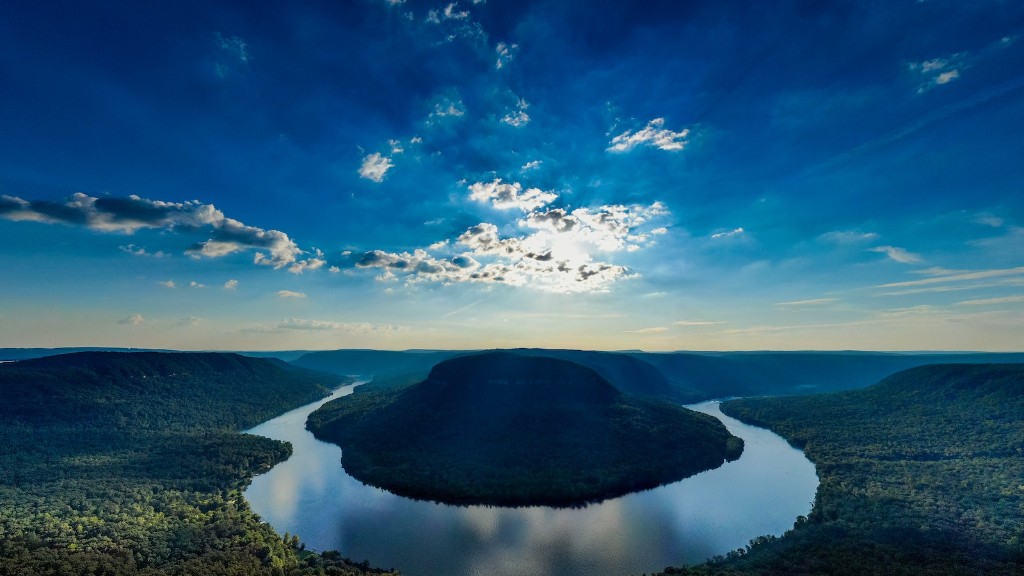The Nile River Valley is a complex, yet fascinating region of North Africa, made up of the river and its tributaries as well as the land around it. Its rich history stretches back over a hundred centuries, with a vast array of human influence and natural evolution. In recent years, environmental and socio-economic changes have put the Nile River Valley at the center of regional development, making it a cultural, political, and economic powerhouse.
The Nile River is deeply intertwined with the history, culture and development of the region. It has long been known as the “horn of plenty” for Egyptians, helping to nurture and sustain them for thousands of years with its flows of rich silt, providing a source of life-giving water for irrigation and sustenance. The capital city of Cairo, with its long and varied history, was founded along the banks of the Nile and has been the economic, political and social heart of the country ever since.
Over the centuries, the influence of the Nile River has been immense. It helped connect the numerous communities along the River, allowing communication and exchange between them, while also making it easier for traders and travelers to navigate the area. The many tributaries that empty into the main River provided an additional lifeline, allowing locals to benefit from the prodigious flow of silt and providing a valuable source of irrigation for agricultural areas.
The Nile River has long been a major source of transport and trade for the region and its inhabitants. The boats from different port cities dotting the Nile were essential to the transport of goods and commodities between upriver and downriver. On the political front, many of the powerful empires that have ruled the region have used the river as a militaristic tool, using multiples of boats and ships to move troops and secure their coveted positions.
The name of “The Father of all Rivers” is certainly due to its deep historical, social and economic importance. In modern times, the impact of the Nile River Valley is still palpable, as it continues to contribute to the livelihood of the locals. Communities along the banks of the River have gained boat access, making their way of life more economical and less labor-intensive. This access, combined with the sustenance deliverable by the River, gives local farmers and merchants ease of travel and unfettered ability to supply their goods and services to markets with much greater frequency.
The importance of the Nile River Valley goes beyond the physical water course itself, to encompass wider societal and economic issues. This region is seen as an example of how the environment, local cultures, and modern development can coexist. The Nile River Valley is a magnet for people from the nearby plains and hinterlands looking to benefit from the educational, medical, and economic opportunities the region provides. Consequently, a myriad of new social, economic and political problems have arisen in recent decades, bringing the need for better management, conservation, and development of natural resources.
Environmental protection has also been highlighted as a priority in recent years in the Nile River Valley, which is currently facing serious threats due to water pollution, drought, soil erosion and destruction of habitats. Various initiatives have been launched to address these threats, such as the Grand Ethiopian Renaissance Dam, watershed management plans, wetland conservation initiatives and policies aimed at promoting sustainable agriculture. If the people of the Nile Valley are to continue to access and benefit from its natural resources, then these initiatives must be taken seriously and implemented properly.
Literary and Cultural History of the Nile River
The Nile River Valley has been an inspiration for art and literature since ancient times. In Ancient Egypt, the gods were often represented in the form of the river god Hapi, in which the gods’ power over its course became mythological. The Nile has also been featured in many classic works of literature, such as Homer’s the Odyssey and Virgil’s Aeneid, among others. The Nile is one of the most important symbols of ancient Egyptian culture, and its monuments and ruins continue to inspire modern writers and artists.
The Nile River has also been the cradle of many famous civilizations. From the ancient Egyptians to the modern Egyptians, the river and its inhabitants have always been closely intertwined in political, social and economic life. In our time, the famous novelist Naguib Mahfouz captured this relationship in his novels, in which he expressed the gritty reality of life along the banks of the river.
The Nile River Valley is an integral part of the culture of many African nations. By following the course of the River, one can experience the varied cultures, histories and traditions of many nations that grind together to create something unique and fascinating. Music, poetry, dance and food all have their roots in the ancient cultures that flourished along the banks of this great river.
Environmental Challenges Facing the Nile River
The Nile River Valley is currently facing serious threats due to water pollution, drought, soil erosion and destruction of habitats. According to the World Bank, the two main sources of water pollution are fertilizer runoff from agricultural operations and untreated wastewater from industrial and residential sources. Pollution and overuse of the River’s resources can have a profound impact on the health of local ecosystems, degrading the quality of ecosystems and decreasing water availability.
In addition, there has been a dramatic decrease in the flow of the River in recent years due to the construction of the Grand Ethiopian Renaissance Dam. This has caused severe levels of water stress, with local ecosystems and communities facing the threat of drought. In order to protect the River’s ecosystems, it is important to take measures, such as improving agricultural practices, controlling wastewater and water pollution, and implementing policies to promote sustainable agriculture.
Other pressing challenges include the destruction of wetlands, which are essential to the functioning of the River. Wetlands act as a buffer between the River and its tributaries, providing important nutrients and habitats for animal and plant life. The destruction of wetlands exacerbates the effects of drought and floods, which also threaten the health of the River’s ecosystems.
In addition, climate change has also had a significant impact on the Nile River Valley. Rising temperatures have caused the River to become warmer and shallower, while drought events have exacerbated water shortages. These changes, if left unaddressed, can have a major impact on the health of the River’s ecosystems and the local population.
Conservation Efforts in the Nile River Valley
In order to protect the Nile River and its delicate ecosystems, there is a need for active conservation efforts. The international community, as well as various governments, non-governmental organizations, and local populations, have developed various initiatives aimed at managing and protecting the River’s resources.
The Grand Ethiopian Renaissance Dam is an example of one such initiative. The hydroelectric dam is being developed to generate electricity while protecting the River and increasing the efficiency of irrigation. In addition, the project aims to create jobs, reduce poverty and improve the livelihoods of local populations.
Furthermore, there have been measures to reduce water pollution, such as improved agricultural practices and wastewater management initiatives, which help to protect water resources while also fostering agricultural development. Furthermore, wetland conservation initiatives have been implemented to help protect the River’s wetlands, which act as a buffer to the River’s flow.
The Nile River Valley is a testament to the power of nature and of human ingenuity. It is an important source of sustenance and development for millions of people and is home to a unique and vibrant culture. In order for the River to continue to thrive into the future, it is essential to take meaningful steps to conserve its resources and protect its ecosystems.
Economic Benefits Provided by the Nile River
The economic benefits provided by the Nile River are essential to the development of its inhabitants. Since antiquity, the River has been used for transport and trade, providing local communities with opportunities for commerce and industry. For this reason, the region has long been a hub for industrial and agricultural production.
Today, the River is still providing economic benefits to the diversified populations across the region. The River has become a major source of transportation, allowing goods and people to be moved upriver and downriver. As a result, local farmers have been able to access new markets, while merchants have benefited from increased trade opportunities.
The Nile also serves as an important source of hydroelectricity, with countries such as Ethiopia and Egypt making use of the River’s flow to generate electricity. The production of hydroelectricity is essential to the economies of these countries, providing a low-cost source of energy and employment to local communities.
The region is also a major tourist destination, with many people attracted to its unique culture, history and scenery. The availability of the River allows for many water activities to be enjoyed, such as boat trips and fishing, which further contribute to the economic development of the region.
The Nile River has provided and continues to provide critical economic benefits to its inhabitants. By harnessing the power of the River, local communities have been able to access new markets, develop new sources of energy, and improve the quality of life for their populations.
Conclusion
The Nile River Valley is a complex, yet fascinating region of North Africa, made up of the river and its tributaries as well as the land around it. Its rich history stretches back over a hundred centuries, and its influence over this time has been immense. It has long been known as the “horn of plenty”, helping to form and sustain the cultures, societies and economies of the region. In recent years, environmental and socio-economic changes have put the Nile River Valley at the center of regional development, making it a cultural, political and economic powerhouse.
The people of the Nile River Valley rely on its natural resources to sustain their livelihoods, and face the challenge of managing and protecting these resources from threats of pollution, drought and habitat destruction. In response, the international community, governments, non-governmental organizations and local populations have developed conservation initiatives to ensure that the River and its resources remain available for future generations. Additionally, the economic benefits provided by the River, in terms of transportation and energy, help to drive the development of the region.
The Nile River Valley is not just a body of water, but a region full of culture, history and people. It has long been an inspiration for art, literature, and other expressions of human creativity and is an integral part of the modern world. Although there are serious challenges to be addressed in order to protect the River’s resources and the local population, it is a region of great promise and possibility.





